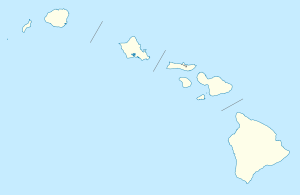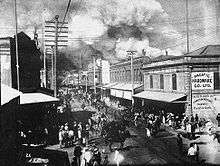Chinatown, Honolulu
|
Chinatown Historic District | |
|
Site of former Wo Fat restaurant | |
 | |
| Location | Beretania Street, Nuuanu Stream, Nuuanu Avenue, and Honolulu Harbor, Honolulu, Hawaii |
|---|---|
| Coordinates | 21°18′44″N 157°51′46″W / 21.31222°N 157.86278°WCoordinates: 21°18′44″N 157°51′46″W / 21.31222°N 157.86278°W |
| Area | 36 acres (15 ha) |
| Built | 1900 |
| NRHP Reference # | 73000658[1] |
| Added to NRHP | January 17, 1973 |
The Chinatown Historic District is a Chinatown neighborhood of Honolulu, Hawaii known for its Chinese American community, and is one of the oldest Chinatowns in the United States.
History
The area was probably used by fishermen in ancient Hawaii but little evidence of this remains. Kealiʻimaikaʻi, the brother of Kamehameha I lived in the area at the end of the 18th century. One of the first early settlers from outside was Isaac Davis and lived there until 1810.[2] Spaniard Don Francisco de Paula Marín lived in the southern end of the area in the early 19th century, and planted a vineyard in the northern end, for which Vineyard Boulevard is named.[3]
During the 19th century laborers were imported from China to work on sugar plantations in Hawaii. Many became merchants after their contracts expired and moved to this area. The ethnic makeup has alway been diverse, peaking at about 56% Chinese people in the 1900 census, and then declining.[4] Honolulu is traditionally known in Chinese as 檀香山 (Tánxiāngshān), meaning Sandalwood Mountain.
Two major fires destroyed many buildings in 1886 and 1900. The 1900 fire was started in an attempt to destroy a building infected with bubonic Plague, which had been confirmed December 12, 1899. Schools were closed and 7000 residents of the area were put under quarantine. After 13 people died, the Board of Health ordered structures suspected of being infected to be burned. Residents were evacuated, and a few buildings were successfully destroyed while the Honolulu Fire Department stood by. However, on January 20, 1900 the fire got out of control after winds shifted, and destroyed most of the neighborhood instead.[5][6]
Many of the buildings date from 1901. Very few were over four stories tall.[4] The natural boundary to the south is Honolulu Harbor, and to the northwest Nuʻuanu stream. Beretania Street is usually considered the northeastern boundary, named after the first British Consul Richard Charlton's ship,[7] and southeastern boundary is Nuʻuanu avenue. A few blocks to the east is the Hawaii Capital Historic District, and adjacent to the south is the Merchant Street Historic District.
In 1904 the Oahu Market was opened by Tuck Young at the corner of King and Kekaulike streets, coordinates 21°18′45″N 157°51′51″W / 21.31250°N 157.86417°W. The simply designed functional construction (a large open-air but covered space divided into stalls) remains in use today for selling fresh fish and produce.[8]
Great Honolulu Chinatown Fire of 1900
| Great Honolulu Chinatown Fire of 1900 | |
|---|---|
 | |
| Location | Chinatown, Honolulu, Hawaii |
| Statistics | |
| Date(s) | January 20-February 6, 1900 |
| Burned area | 38 acres (150,000 m2) |
| Land use | urban |
| Fatalities | 1 in honolulu, 9 on maui (all from plague) |
From witnesses a wave of bubonic plague was introduced to Honolulu on October 20, 1899 by an off loaded shipment of rice which had been carrying rats from the America Maru. At that time, Chinese immigration to Hawaii resulted in a crowded residential area called Chinatown with poor living conditions and sewage disposal. Plague infected 11 people. The response by the Board of Health included incinerating garbage, renovating the sewer system, putting Chinatown under quarantine, and most of all burning infected buildings. 41 fires were set, but on January 20, 1900 winds picked up and the fire spread to other buildings which was undesired.[9] The runaway fire burned for seventeen days and scorched 38 acres (15 Ha) of Honolulu. The fire campaign continued for another 31 controlled burns after the incident. The 7,000 homeless residents were housed in detention camps to maintain the quarantine until April 30. A total of 40 people died of the plague.
Critics accused the government of being driven by Sinophobia; regardless of the fire most likely being an accident, an exodus occurred. While the people rebuilt, they began to live in suburbs while continuing to work in Chinatown, to avoid going homeless if another disaster occurred. In addition the post-fire architecture began using masonry rather than wood, since the stone and brick buildings proved much more fire resistant during the fire.
Many of the people who filed damage claims were represented by lawyer Paul Neumann (not to be confused with the actor), but he died before the cases went to court.[10]
Preservation
After World War II the area fell into disrepair and became a red-light district.[11] About 36 acres (15 ha) of the district was added to the National Register of Historic Places listings in Oahu on January 17, 1973 as site 73000658.[1] During the administrations of mayors Frank Fasi and Jeremy Harris the area was targeted for revitalization. Restrictions on lighting and signs were relaxed to promote nightlife.[11] Special zoning rules were adopted for the area.[12] The Hawaii National Bank was founded in the district in 1960, and has its headquarters there.[13]
On the eastern edge of the district, the Hawaii Theatre was restored and re-opened in 1996.[14] The area around the theatre is called the Arts District. In 2005 a small park near the theatre at the corner of Hotel and Bethel streets was opened and called Chinatown Gateway Park.[15] In November 2007 the park was named in honor of Sun Yat-Sen who came to Chinatown in 1879 where he was educated and planned the Chinese Revolution of 1911.[16] Honolulu Chinatown was included in the Preserve America program.[17]
Government and infrastructure
The Downtown Police Substation of the Honolulu Police Department is located in Chinatown.[18] Officials broke ground for the substation on Friday September 18, 1998. Mayor Jeremy Harris said that he wanted a police station built at that location because of crime had been occurring in that area, and the presence of a police station would deter crime.[19]
Popular culture
The character Charlie Chan was based on detective Chang Apana (1871–1933). Earl Derr Biggers read about Apana and based the character in Honolulu after a vacation in 1919.[20] The character Wo Fat in the TV series Hawaii Five-O was named after a restaurant in Honolulu's Chinatown. The business first opened in 1882, but the building was destroyed in the 1886 fire. A new building was built after the 1900 fire, and then another in 1932. It was located at 115 North Hotel Street, 21°18′44.4″N 157°51′47″W / 21.312333°N 157.86306°W.[21] The Wo Fat Restaurant closed in 2005,[22] and the building now houses a nightclub.[23]
References
- 1 2 National Park Service (2009-03-13). "National Register Information System". National Register of Historic Places. National Park Service.
- ↑ Richard A. Greer (1998). "Along the Old Honolulu Waterfront". Hawaiian Journal of History. 32. Hawaii Historical Society. pp. 53–66. hdl:10524/430.
- ↑ Mary Kawena Pukui and Elbert (2004). "lookup of vineyard". on Place Names of Hawai'i. Ulukau, the Hawaiian Electronic Library, University of Hawaii. Retrieved 2010-04-09.
- 1 2 Dorothy Riconda (May 2, 1972). "Chinatown Historic District nomination form". National Register of Historic Places. U.S. National Park Service. Retrieved 2010-04-09.
- ↑ "Honolulu Responds to the Plague". Hawaii state historic preservation division. 2002. Retrieved 2010-04-08.
- ↑ Michael Tsai (July 2, 2006). "Bubonic plague and the Chinatown fire". Honolulu Advertiser. Retrieved 2010-04-11.
- ↑ Mary Kawena Pukui and Elbert (2004). "lookup of Beretania". on Place Names of Hawai'i. Ulukau, the Hawaiian Electronic Library, University of Hawaii. Retrieved 2010-04-09.
- ↑ Burl Burlingame (December 14, 2003). "Efficient design and perfect location define market". Honolulu Star-Bulletin. Retrieved 2010-04-09.
- ↑ www.hawaiiforvisitors.com
- ↑ "Local and General News: The Last Ceremony". The Independent. Honolulu. July 3, 1901. Retrieved July 18, 2010.
- 1 2 Peter Wagner (September 29, 1998). "Chinatown: A bike city waiting to be reborn". Honolulu Star-Bulletin. Retrieved 2010-04-09.
- ↑ "Chinatown Special District Design guidelines" (PDF). City and County of Honolulu. April 1991. Retrieved 2010-04-09.
- ↑ "Hawaii National Bank". official web site. 2009. Retrieved 2010-04-09.
- ↑ "Hawaii Theatre Center: History". web site. Retrieved 2010-04-09.
- ↑ "Mayor Announces Reopening Of Chinatown Gateway Park". The City and County of Honolulu. November 5, 2005. Retrieved 2010-04-09.
- ↑ "City to Dedicate Statue and Rename Park to Honor Dr. Sun Yat-Sen". The City and County of Honolulu. November 12, 2007. Retrieved 2010-04-09.
- ↑ "Preserve America Community: Chinatown Special Historic District, Honolulu, Hawaii". April 21, 2009. Retrieved 2010-04-09.
- ↑ "Contacting HPD." Honolulu Police Department. Retrieved on May 19, 2010.
- ↑ Constantino, Stan. "New era in crime fight begins in Chinatown." Honolulu Star-Bulletin. Saturday September 19, 1998. Retrieved on May 19, 2010.
- ↑ Jaymes K. Song (October 2, 1999). "'Charlie Chan' isle's toughest crime fighter". Honolulu Star-Bulletin. Retrieved 2010-04-09.
- ↑ Burl Burlingame (December 28, 2003). "Like a phoenix, Wo Fat always rises". Honolulu Star-Bulletin. Retrieved 2010-04-09.
- ↑ Sigall, Bo (March 2, 2012). "Wo Fat Restaurant Lives on as Name of 'Five-0' Villain". Honolulu Star-Advertiser. Retrieved 2014-07-14.
- ↑ Daniel Gray. "The Loft Gallery and Lounge". web site. Retrieved 2010-04-09.
Further reading
- James C. Mohr (2005). Plague and fire: battling black death and the 1900 burning of Honolulu's Chinatown. Oxford University Press US. ISBN 978-0-19-516231-8.
External links
- "Honolulu's Chinatown". community web site. Retrieved 2010-04-09.